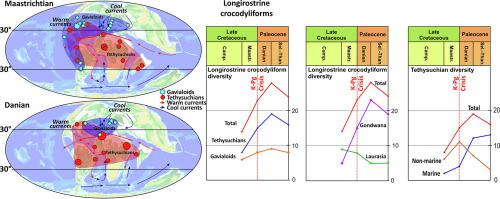Gondwana Research ( IF 7.2 ) Pub Date : 2021-06-30 , DOI: 10.1016/j.gr.2021.06.020 Stéphane Jouve

|
The evolution of the crocodyliforms through the K-Pg crisis has often been evaluated, but each time, the crocodyliforms were considered as forming a homogeneous group. I considered here, the evolution of two longirostrine taxa from the Campanian to the Thanetian: tethysuchians and gavialoids. The gavialoids are almost restricted to Laurasian continents, where tethysuchians form most of the Gondwanan crocodyliform fauna. This segregation can be compared with climatic distribution: tethysuchians are restricted to hot climatic areas, where gavialoids are restricted to a northern, warm temperate climatic belt from where tethysuchians were almost excluded. This suggests that gavialoids were more tolerant of cooler climates than tethysuchians. The tethysuchians could have been excluded from the European continent by the existence of a cool European oceanic current, whilst on the contrary, the presence of a proto-gulfstream along north-east American coast could have allowed the presence of some tethysuchians in marine realm in this area. Both gavialoids and tethysuchians strongly diversified after the K-Pg crisis, particularly on Gondwanan continents, and mostly with tethysuchian species. Most of these tethysuchians were non-marine during the Maastrichtian, and the number of marine species strongly increases after the K-Pg crisis, whilst the number of non-marine ones remains nearly constant. This rise of marine diversity compared to non-marine forms is congruent with previous hypotheses suggesting that the crocodyliforms did not suffer from the K-Pg crisis, but on the contrary, benefited from the extinction of large marine reptiles to diversify after the crisis mainly in this environment. So, if the history of the crocodyliforms on the whole is important, the evolution of each group should be considered separately, as their evolution could be influenced by regional environmental conditions and factors.
中文翻译:

通过 K-Pg 边界的差异多样化,以及 longirostrine crocodyliforms 的危机后机会主义
鳄鱼通过 K-Pg 危机的进化经常被评估,但每次,鳄鱼都被认为形成了一个同质的群体。我在这里考虑了从坎帕尼亚到塔尼提亚的两个长链环线类群的进化:特提鳄类和 gavialoids。gavialoids 几乎仅限于劳亚大陆,在那里 Tethysuchians 形成了大部分冈瓦纳鳄鱼形动物群。这种隔离可以与气候分布进行比较:tethysuchians 仅限于炎热的气候区域,在那里 gavialoids 仅限于北部的暖温带气候带,在那里几乎排除了 tethysuchians。这表明 gavialoids 比 tethysuchians 更能容忍凉爽的气候。由于存在凉爽的欧洲洋流,特提鳄本可以被排除在欧洲大陆之外,而相反,沿美国东北海岸的原始湾流的存在可能允许一些特提鳄在海洋领域的存在这片区域。在 K-Pg 危机之后,特别是在冈瓦纳大陆上,虎鲸类动物和 tethysuchians 都发生了强烈的多样化,并且主要是 tethysuchian 物种。在马斯特里赫特时代,这些特提鳄类动物中的大多数是非海洋物种,在 K-Pg 危机之后,海洋物种的数量大幅增加,而非海洋物种的数量几乎保持不变。与非海洋形式相比,这种海洋多样性的增加与之前的假设一致,即鳄鱼类没有遭受 K-Pg 危机,但恰恰相反,受益于大型海洋爬行动物的灭绝,危机后主要是在这种环境下进行多样化。所以,如果鳄鱼的历史总体上很重要,每个群体的进化应该分开考虑,因为它们的进化可能会受到区域环境条件和因素的影响。









































 京公网安备 11010802027423号
京公网安备 11010802027423号